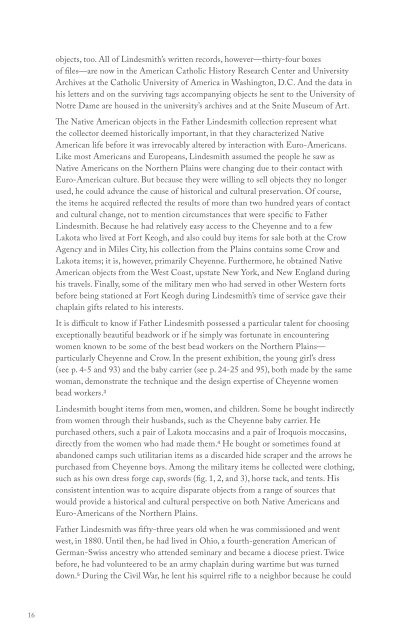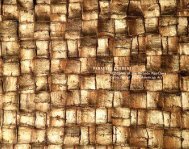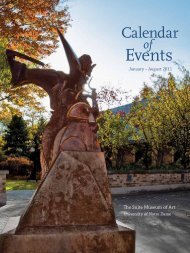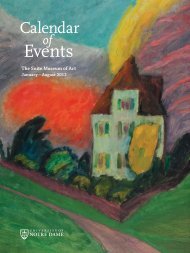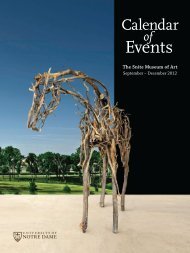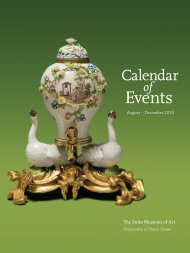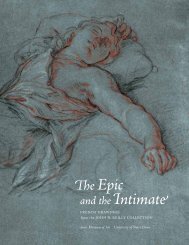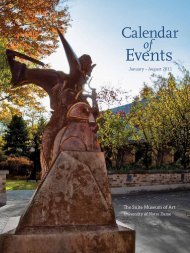HISTORY INTO ART AND ANTHROPOLOGY - Snite Museum of Art ...
HISTORY INTO ART AND ANTHROPOLOGY - Snite Museum of Art ...
HISTORY INTO ART AND ANTHROPOLOGY - Snite Museum of Art ...
Create successful ePaper yourself
Turn your PDF publications into a flip-book with our unique Google optimized e-Paper software.
objects, too. All <strong>of</strong> Lindesmith’s written records, however—thirty-four boxes<br />
<strong>of</strong> files—are now in the American Catholic History Research Center and University<br />
Archives at the Catholic University <strong>of</strong> America in Washington, D.C. And the data in<br />
his letters and on the surviving tags accompanying objects he sent to the University <strong>of</strong><br />
Notre Dame are housed in the university’s archives and at the <strong>Snite</strong> <strong>Museum</strong> <strong>of</strong> <strong>Art</strong>.<br />
The Native American objects in the Father Lindesmith collection represent what<br />
the collector deemed historically important, in that they characterized Native<br />
American life before it was irrevocably altered by interaction with Euro-Americans.<br />
Like most Americans and Europeans, Lindesmith assumed the people he saw as<br />
Native Americans on the Northern Plains were changing due to their contact with<br />
Euro-American culture. But because they were willing to sell objects they no longer<br />
used, he could advance the cause <strong>of</strong> historical and cultural preservation. Of course,<br />
the items he acquired reflected the results <strong>of</strong> more than two hundred years <strong>of</strong> contact<br />
and cultural change, not to mention circumstances that were specific to Father<br />
Lindesmith. Because he had relatively easy access to the Cheyenne and to a few<br />
Lakota who lived at Fort Keogh, and also could buy items for sale both at the Crow<br />
Agency and in Miles City, his collection from the Plains contains some Crow and<br />
Lakota items; it is, however, primarily Cheyenne. Furthermore, he obtained Native<br />
American objects from the West Coast, upstate New York, and New England during<br />
his travels. Finally, some <strong>of</strong> the military men who had served in other Western forts<br />
before being stationed at Fort Keogh during Lindesmith’s time <strong>of</strong> service gave their<br />
chaplain gifts related to his interests.<br />
It is difficult to know if Father Lindesmith possessed a particular talent for choosing<br />
exceptionally beautiful beadwork or if he simply was fortunate in encountering<br />
women known to be some <strong>of</strong> the best bead workers on the Northern Plains—<br />
particularly Cheyenne and Crow. In the present exhibition, the young girl’s dress<br />
(see p. 4-5 and 93) and the baby carrier (see p. 24-25 and 95), both made by the same<br />
woman, demonstrate the technique and the design expertise <strong>of</strong> Cheyenne women<br />
bead workers. 3<br />
Lindesmith bought items from men, women, and children. Some he bought indirectly<br />
from women through their husbands, such as the Cheyenne baby carrier. He<br />
purchased others, such a pair <strong>of</strong> Lakota moccasins and a pair <strong>of</strong> Iroquois moccasins,<br />
directly from the women who had made them. 4 He bought or sometimes found at<br />
abandoned camps such utilitarian items as a discarded hide scraper and the arrows he<br />
purchased from Cheyenne boys. Among the military items he collected were clothing,<br />
such as his own dress forge cap, swords (fig. 1, 2, and 3), horse tack, and tents. His<br />
consistent intention was to acquire disparate objects from a range <strong>of</strong> sources that<br />
would provide a historical and cultural perspective on both Native Americans and<br />
Euro-Americans <strong>of</strong> the Northern Plains.<br />
Father Lindesmith was fifty-three years old when he was commissioned and went<br />
west, in 1880. Until then, he had lived in Ohio, a fourth-generation American <strong>of</strong><br />
German-Swiss ancestry who attended seminary and became a diocese priest. Twice<br />
before, he had volunteered to be an army chaplain during wartime but was turned<br />
down. 5 During the Civil War, he lent his squirrel rifle to a neighbor because he could<br />
not join the military himself. The gun was returned to him after the war, and he<br />
later donated it to the University <strong>of</strong> Notre Dame. 6 Upon retiring from the army,<br />
he returned to Ohio and spent the rest <strong>of</strong> his career as a diocese priest and then as<br />
a chaplain for various institutions. He died in 1921 at age ninety-four.<br />
When Lindesmith returned to Ohio from Montana in 1891, he intended to display<br />
his collection for the edification <strong>of</strong> his parishioners. But when he realized that his<br />
priestly duties did not allow him the time to organize and exhibit the collection,<br />
he decided to donate it. 7 He began by giving roughly half the collection to the<br />
Catholic University <strong>of</strong> America in Washington, D.C., in 1898. The following year,<br />
he donated approximately one-quarter <strong>of</strong> it to the University <strong>of</strong> Notre Dame and<br />
most <strong>of</strong> the rest <strong>of</strong> his holdings to St. Ignatius College in Cleveland. He also gave<br />
a few items to the American College <strong>of</strong> Rome. 8 He probably felt that donating<br />
his acquisitions to Catholic colleges meant that the objects would be used to help<br />
educate younger generations. Significantly, he had personal reasons to honor three<br />
<strong>of</strong> the institutions he chose: He had baptized Father John W. Cavanaugh, a president<br />
emeritus <strong>of</strong> Notre Dame, and a nephew <strong>of</strong> his was enrolled in a seminary<br />
at the school. Lindesmith had visited Washington, D.C., just after the Catholic<br />
University <strong>of</strong> America was founded. And St. Ignatius College, a Jesuit institution,<br />
was near the area <strong>of</strong> Ohio where Father Lindesmith had a parish.<br />
In her essay in this book, Bethany Montagano explores Lindesmith’s motives for<br />
collecting. The diaries and other documents in his archived papers confirm his goal<br />
<strong>of</strong> collecting and exhibiting objects that illustrated aspects <strong>of</strong> late-nineteenthcentury<br />
life in the American West. He notes more than once that these items, no<br />
matter how mundane, would enable people in the future to gain a better grasp <strong>of</strong><br />
the cultures <strong>of</strong> the West, particularly <strong>of</strong> the Northern Plains. The Native American<br />
portion <strong>of</strong> the collection, in particular, increases our understanding and appreciation<br />
<strong>of</strong> that area <strong>of</strong> art from this period. Of even greater value than the objects<br />
themselves is the legacy Father Lindesmith conveyed by thoughtfully documenting<br />
the historical and cultural particulars <strong>of</strong> his acquisitions.<br />
1. Father Lindesmith Collection, American Catholic History Research Center and University<br />
Archives, Catholic University <strong>of</strong> America (hereafter cited as FLC/ACHRCUA): Box 7, file 8,<br />
Lindesmith to Pr<strong>of</strong>essor Henry Hyvernat, D.D., March 1911.<br />
2. FLC/ACHRCUA: Box 5, file 6, memorandum 24; Box 21, account book 4; Box 5, memoranda<br />
27–29; Box 5, memoranda 30—32A.<br />
3. FLC/ACHRCUA: Box 21, file 5, account book 3; Box 7, file 8, Lindesmith to Pr<strong>of</strong>essor Henry<br />
Hyvernat, D.D., April 5, 1911.<br />
4. FLC/ACHRCUA: Box 21, file 5, account book 3; Box 7, file 8, object tag 473.<br />
5. Carlos Davila, “The Mustard Seed in Montana: Father Eli W. J. Lindesmith and the Spirit <strong>of</strong> Order<br />
and Progress in the American West, 1880 to 1891,” PhD diss., Catholic University <strong>of</strong> America, 2005<br />
(Saarbruken, Germany: VDM Verlag Dr. Muller Aktiengesellschaft, 2008).<br />
6. FLC/ACHRCUA: Box 7, file 8, Lindesmith to Hyvernat, March 1911.<br />
16 17<br />
7. Ibid.<br />
8. Ibid.


